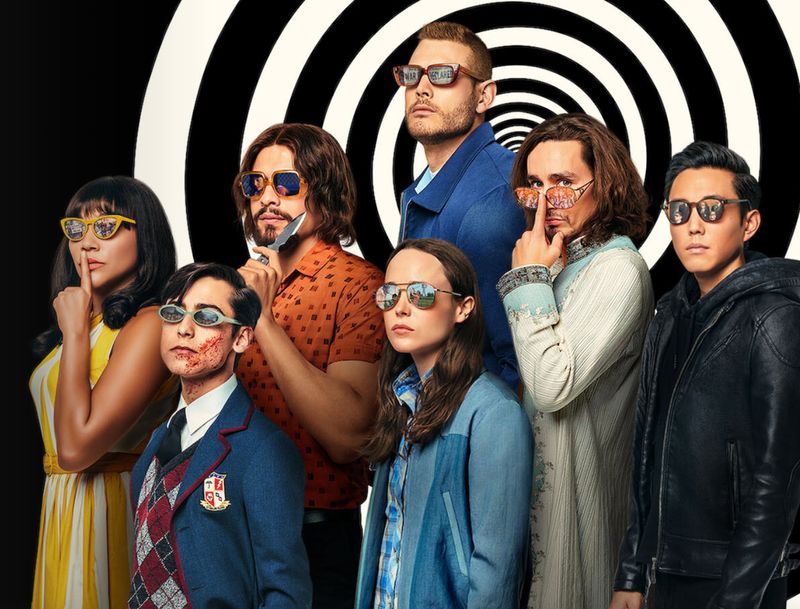Created in 2019 by Steve Blackman and Jeremy Slater, Netflix’s The Umbrella Academy has amassed a pretty strong fan following over two seasons. An audience who revels in the escapades of the dysfunctional Hargreeves family. With the third season scheduled to premiere on June 22nd, 2022, fans are pretty delighted to see the Umbrella Academy clash with the Sparrow Academy.
Since the series is adapted from Gerard Way and Gabriel Ba’s graphic novel, it is interesting to see if and how the series has stayed faithful to the original source. Written by Gerard Way and illustrated by Ba, this Eisner Award-winning comic has been released in three parts, namely Apocalypse Suit, Dallas and Hotel Oblivion. The Netflix series has used Way and Ba’s comic as a framework for their seasons. The first season sees a subtle mix between the storylines of Apocalypse Suit and Dallas while the second season borrows from Dallas and slightly alters certain parts from Hotel Oblivion.
The cast of The Umbrella Academy includes Elliot Page, Aidan Gallagher, Justin H. Min, Robert Sheehan, David Castaneda, Tom Hopper, and Colm Feore. They will be joined by new faces in the third season, namely Justin Cornwell, Britney Oldford, Genesis Rodriguez, Cazzie David and Jake Epstein.
Ahead of the third season’s release, where one of the key differences has already been noted – the Sparrows on the show are an alternate version of the Umbrella Academy and mere teenagers unlike the comic where they are all grown superheroes – let us take a look at some of the differences between the comic and the show.
5 differences between ‘The Umbrella Academy’ graphic novel and the Netflix show
The Hargreeves have slightly different powers
The Hargreeves in the graphic novels have slightly different powers from their counterparts in the show. To make the siblings appear “more human”, the showrunners altered some of their powers to make it seem more realistic and believable.
In the comic, Diego, a brilliant knife-thrower, can also hold his breath underwater indefinitely. Klaus can levitate and use airwaves for communications. Allison is more powerful in the comics, with the ability to warp reality. However, the only person who is more powerful on the show than in the comic is Vanya. While comic Vanya can only use her violin, Vanya on the show has the ability to use any soundwave.
Klaus and Vanya are not LGBTQ+ characters in Way’s comic
Way’s comic features predominantly heterosexual characters. All the Hargreeves children are straight as of now and some even indulge in romantic pursuits. However, the Netflix show subverts the inherent heteronormativity aligned with superheroes and includes LGBTQ+ characters.
In the show, Vanya is a lesbian who is in a healthy relationship in season two. Klaus never bothers to clarify his sexuality and might be either pansexual or bisexual. Steve Blackman explained how they wanted to “tell an interesting love story between Vanya and Sissy and [explore] what it would be like to be gay or queer in 1963 and how much risk there was.”
Vanya is paralysed in the comics
In the finale of the comic’s first volume, namely Apocalypse Suit, Five puts an end to Vanya and her catastrophic powers by shooting her in the head. However, in the show, Allison is the one to pull the trigger, catching Vanya close by the ear.
Five’s action leads to a paralysed Vanya in the comic who also suffers from memory loss. While the arc of amnesia is reflected in the Netflix show as well, Vanya is able-bodied on the show.
Netflix’s ‘The Umbrella Academy’ is more diverse
Way’s comic is predominantly white, especially the seven children. The show, however, has a very diverse cast and includes plenty of people of colour. Black woman Emmy Raver-Lampman is seen as Allison, Korean-American actor Justin H. Min plays Ben while Mexican-American star David Casteneda is seen as Diego. Unlike a blonde Diego in the comic, Casteneda sports his black hair.
The streamer has always been very vocal about their ideas of making the shows diverse and inclusive. The show also manages to subvert the typical ideas of an all-white superhero cast and has a wide range of actors in various roles, making it interesting. It even sees Mary J. Blige as the stunning antagonist Cha-Cha. Additionally, Cha-Cha is a man in the comic. They successfully gender swap the character, making Blige appear more badass than ever with her new character arc.
Netflix portrays the Vietnam War differently
The Vietnam War arc in the comic is very different from its show representation. In the comic, Diego, Luther and Klaus all travel back to the war period and stay stuck there. After ending up in the timeline of 1960s Vietnam instead of travelling to Dallas in 1963 to prevent Five and Allison from killing US President John F. Kennedy, the trio kill time by partaking in the war.
The show, however, has a totally different perspective from Dallas’ fifth issue. In the show, Vietnam War constitutes an integral part of the narrative, Klaus travels to Vietnam alone via Cha-Cha and Hazel’s time-travel briefcase. He fights in the war and falls for David who tragically dies. Grieving his death, a traumatised Klaus and his story receive significant attention.
